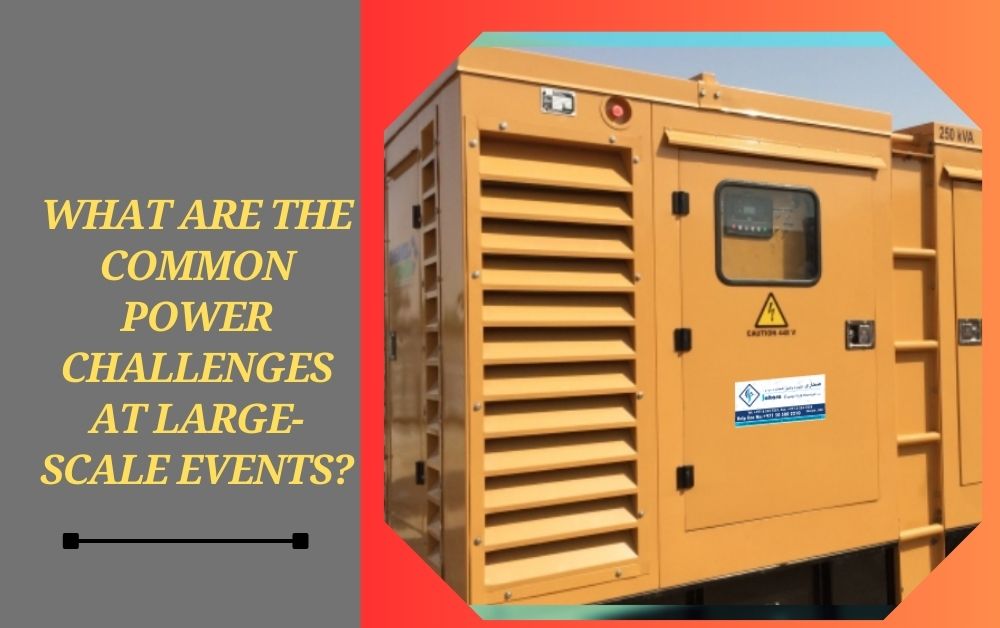Organizing a large-scale event, whether it’s a concert, festival, conference, or sports event, involves meticulous planning and coordination. One of the most critical aspects of ensuring a successful event is managing the power supply. Power challenges can disrupt the flow of an event, cause safety hazards, and lead to unhappy attendees. In this blog, we will explore the common power challenges faced at large-scale events and discuss effective solutions to overcome them. By understanding these challenges, event planners can ensure a smooth and memorable experience for all participants.
Understanding Power Needs for Large-Scale Events
Why Is Power Important for Events?
Power is the backbone of any event, providing energy to various essential components such as lighting, sound systems, stages, and electronic devices. Reliable power ensures that all technical aspects function seamlessly, enhancing the overall experience for attendees. Without adequate power, events can suffer from technical glitches, safety issues, and a decline in attendee satisfaction.
Note: The right power for events is crucial for delivering a memorable experience. Proper electrical supply supports all essential components, including lighting, sound systems, and catering equipment. Planning ahead for your power needs helps avoid unexpected disruptions during your gathering. For professional and reliable power solutions, partner with Sahara Equipments. Let us assist you in making your event unforgettable! Contact us today to get started!
Assessing Power Requirements
Before addressing power challenges, it’s crucial to assess the power needs of your event. This involves:
- Inventory of Equipment: List all electrical devices and their power ratings.
- Peak Power Demand: Identify the highest power consumption periods.
- Backup Needs: Plan for backup power sources in case of outages.
- Venue Specifications: Understand the power capacity and limitations of the event location.
Common Power Challenges at Large-Scale Events
1. Insufficient Power Supply
What Causes Insufficient Power?
Insufficient power supply occurs when the available electrical capacity cannot meet the event’s demand. This can happen due to:
- Underestimating Power Needs: Failing to accurately calculate the total power required.
- Venue Limitations: The event venue’s electrical infrastructure may not support high power demands.
- Multiple Power Sources: Relying on temporary power setups that aren’t robust enough.
Impact of Insufficient Power
- Technical Failures: Sound systems, lighting, and other equipment may malfunction.
- Event Interruptions: Sudden power cuts can halt performances or presentations.
- Safety Hazards: Inadequate power can lead to overheating and electrical fires.
2. Power Outages and Interruptions
Causes of Power Outages
Power outages can occur due to:
- Grid Failures: Local power grid issues can disrupt the entire event’s power supply.
- Equipment Overload: Overloading circuits can trip breakers and cause outages.
- Weather Conditions: Storms and extreme weather can damage power lines and equipment.
Consequences of Power Outages
- Disrupted Schedule: Performances and activities may be delayed or canceled.
- Safety Risks: Lack of lighting can create hazards for attendees.
- Reputational Damage: Frequent outages can tarnish the event’s reputation.
3. Electrical Overload
What Is Electrical Overload?
Electrical overload happens when the power demand exceeds the capacity of the electrical system. This can lead to:
- Tripped Circuit Breakers: Safety devices shut off power to prevent damage.
- Overheating Wires: Excessive current can cause wires to overheat and potentially catch fire.
How Overload Affects Events
- Intermittent Power: Equipment may turn on and off unpredictably.
- Permanent Damage: Continuous overload can damage electrical equipment permanently.
- Safety Risks: Overheated wires pose a fire hazard.
4. Inadequate Backup Power Solutions
Importance of Backup Power
Backup power is essential to keep the event running smoothly during unexpected power failures. Without reliable backup solutions, an event is vulnerable to significant disruptions.
Common Backup Power Issues
- Insufficient Capacity: Backup generators may not provide enough power for all event needs.
- Delayed Start: Generators taking too long to kick in can cause initial power gaps.
- Fuel Shortages: Running out of fuel can leave backup systems inoperable.
5. Poor Power Distribution
What Is Power Distribution?
Power distribution involves allocating electrical power from the main supply to various equipment and areas within the event venue.
Challenges in Power Distribution
- Uneven Distribution: Some areas may receive more power than needed, while others are underpowered.
- Complex Layouts: Large venues with multiple stages and zones can complicate power distribution.
- Insufficient Outlets: Not having enough electrical outlets can limit where equipment can be placed.
6. Safety Compliance Issues
Importance of Electrical Safety
Electrical safety is paramount to prevent accidents, injuries, and damage to equipment. Non-compliance with safety standards can lead to severe consequences.
Common Safety Challenges
- Lack of Proper Wiring: Using inadequate or outdated wiring can increase the risk of electrical fires.
- Overloaded Circuits: Plugging too many devices into a single outlet can cause overloads.
- Inadequate Grounding: Proper grounding prevents electrical shocks and equipment damage.
7. Environmental and Venue Constraints
Environmental Factors
Outdoor events face unique power challenges, including:
- Weather Variability: Rain, wind, and extreme temperatures can affect power systems.
- Terrain Issues: Uneven or unstable ground can complicate generator placement and wiring.
Venue Constraints
- Limited Power Access: Some venues have restricted power access points, making it difficult to meet power demands.
- Space Limitations: Limited space can restrict the placement of power equipment and cables.

Solutions to Common Power Challenges
1. Accurate Power Planning
Steps for Effective Power Planning
- Conduct a Power Audit: Assess all equipment and their power requirements.
- Consult Professionals: Work with electrical engineers or power consultants to design a reliable power plan.
- Include Contingencies: Plan for unexpected power needs and fluctuations.
Benefits of Accurate Power Planning
- Prevents Overload: Ensures the power supply matches the demand.
- Reduces Risks: Minimizes the chances of outages and technical failures.
- Enhances Efficiency: Optimizes power usage, reducing waste and costs.
2. Reliable Backup Power Systems
Choosing the Right Backup Power
- Generators: Select generators with sufficient capacity to handle all critical equipment.
- Uninterruptible Power Supplies (UPS): Use UPS systems for sensitive electronics that need immediate power backup.
- Fuel Management: Ensure an ample and steady supply of fuel for generators.
Maintenance and Testing
- Regular Testing: Test backup systems before the event to ensure they function correctly.
- Maintenance: Keep backup equipment well-maintained and ready for use.
- On-Site Support: Have technicians available to manage and troubleshoot backup systems during the event.
3. Efficient Power Distribution
Designing an Effective Power Distribution System
- Zoning: Divide the event area into zones, each with its own power distribution setup.
- Dedicated Circuits: Use separate circuits for high-demand areas to prevent overloads.
- Proper Cabling: Use high-quality cables and connectors to ensure reliable power flow.
Implementing Smart Distribution Techniques
- Load Balancing: Distribute power evenly across all areas to avoid overloading specific circuits.
- Cable Management: Organize and secure cables to prevent tripping hazards and ensure efficient power delivery.
- Surge Protection: Use surge protectors to safeguard equipment from power spikes.
4. Adhering to Safety Standards
Compliance with Electrical Codes
- Local Regulations: Follow local electrical codes and regulations to ensure safety.
- Professional Installations: Hire licensed electricians to install and manage power systems.
- Regular Inspections: Conduct safety inspections before and during the event.
Implementing Safety Protocols
- Training: Train staff on electrical safety practices and emergency procedures.
- Clear Signage: Use signs to indicate power sources, emergency shut-offs, and safety equipment locations.
- Emergency Plans: Develop and communicate clear plans for handling electrical emergencies.
5. Leveraging Technology and Innovation
Smart Power Management Systems
- Automated Controls: Use systems that can automatically adjust power distribution based on demand.
- Real-Time Monitoring: Implement tools to monitor power usage and detect issues in real-time.
- Data Analytics: Analyze power usage data to optimize future events.
Renewable Energy Solutions
- Solar Power: Incorporate solar panels for sustainable and reliable energy.
- Wind Power: Utilize portable wind turbines where feasible.
- Energy Storage: Use batteries to store excess energy for use during peak demand times.
6. Collaborating with Experienced Power Providers
Selecting the Right Power Partner
- Experience: Choose power providers with a proven track record in handling large-scale events.
- Comprehensive Services: Opt for companies that offer planning, installation, maintenance, and support.
- Flexibility: Ensure the provider can adapt to changing power needs during the event.
Building a Strong Relationship
- Communication: Maintain clear and ongoing communication with your power provider.
- Feedback: Provide feedback on their services to improve future collaborations.
- Partnership: Treat your power provider as a partner invested in the success of your event.
7. Contingency Planning
Developing Backup Plans
- Multiple Power Sources: Use more than one backup power source to ensure redundancy.
- Alternative Venues: Have alternative plans for venue power if the primary site fails.
- Emergency Supplies: Stock essential items like extension cords, adapters, and emergency generators.
Testing Contingency Plans
- Simulations: Conduct drills to practice responding to power failures.
- Review and Adjust: Regularly review and update contingency plans based on lessons learned from previous events.
Real-World Examples of Power Challenges and Solutions
Case Study 1: Music Festival Power Management
Challenge: A large outdoor music festival faced power outages due to unexpected high demand for sound and lighting equipment.
Solution:
- Accurate Power Assessment: Conducted a thorough power audit to estimate total demand.
- Multiple Generators: Deployed several generators to distribute the load and provide redundancy.
- Real-Time Monitoring: Implemented a monitoring system to track power usage and adjust as needed.
Outcome: The festival ran smoothly without any significant power disruptions, ensuring a great experience for attendees and performers.
Case Study 2: Corporate Conference Power Planning
Challenge: A multi-day corporate conference struggled with uneven power distribution, leading to frequent equipment shutdowns.
Solution:
- Zoning Strategy: Divided the conference venue into zones, each with dedicated power circuits.
- Surge Protectors: Installed surge protectors to safeguard sensitive electronic devices.
- Professional Support: Hired a professional power management team to oversee the setup and operation.
Outcome: The conference experienced stable power distribution, allowing all presentations and activities to proceed without interruptions.
Case Study 3: Sports Event Power Safety
Challenge: A major sports event encountered safety issues due to overloaded power circuits, posing risks to both equipment and attendees.
Solution:
- Safety Audits: Conducted comprehensive safety audits to identify and address potential hazards.
- Proper Grounding: Ensured all electrical systems were properly grounded to prevent shocks.
- Emergency Response Plan: Developed a clear plan for responding to electrical emergencies.
Outcome: The sports event maintained high safety standards, preventing any electrical accidents and ensuring a secure environment for everyone involved.
Tips for Effective Power Management at Large-Scale Events
Plan Ahead
Start planning your power needs well in advance. Early planning allows you to identify potential challenges and address them before they become issues. Collaborate with power providers, venue managers, and technical teams to create a comprehensive power plan.
Invest in Quality Equipment
Use high-quality power equipment, such as generators, cables, and distribution systems. Reliable equipment reduces the risk of failures and ensures consistent power delivery throughout the event.
Train Your Team
Ensure that your team is well-trained in managing and troubleshooting power systems. Knowledgeable staff can quickly address minor issues, preventing them from escalating into major problems.
Communicate Clearly
Maintain clear communication with all stakeholders, including power providers, venue staff, and event personnel. Effective communication ensures that everyone is aware of the power plan and their roles in maintaining it.
Monitor Continuously
Use monitoring tools to keep track of power usage in real-time. Continuous monitoring helps you detect and address issues promptly, ensuring that power remains stable throughout the event.
Prioritize Critical Systems
Identify and prioritize critical systems that must remain powered at all times, such as medical equipment, lighting, and communication systems. Ensure these systems have dedicated power sources and backup solutions.
Document Everything
Keep detailed records of your power plan, including equipment used, maintenance schedules, and contingency plans. Documentation helps you review and improve your power management strategies for future events.
Conclusion
Managing power at large-scale events is a complex but essential task that can significantly impact the success of the event. By understanding the common power challenges—such as insufficient power supply, power outages, electrical overloads, inadequate backup power, poor distribution, safety compliance issues, and environmental constraints—and implementing effective solutions, event planners can ensure a seamless and safe experience for all attendees.
Proper power planning, reliable backup systems, efficient distribution, adherence to safety standards, leveraging technology, collaborating with experienced providers, and having robust contingency plans are key strategies to overcome power challenges. Additionally, learning from real-world examples and following best practices can help you navigate the complexities of power management with confidence.
For More Insightful Articles Related To This Topic, Feel Free To Visit: technonetwork.


